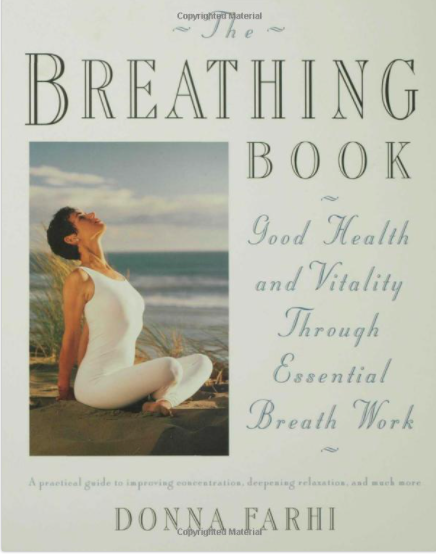Breathing Patterns That Affect The Way You Sound
Does your voice as lack depth and luster? Do you feel tightness in your throat? Do you repeat yourself frequently because people can’t hear you? You might have a breathing problem.
Do you feel tightness in your throat? Do you repeat yourself frequently because people can’t hear you? You might have a breathing problem.
Donna Farhi, yoga extraordinaire, and author of The Breathing Book: Good Health and Vitality Through Essential Breath Work wrote this book on breath to help integrate breathing and movement but it’s helpful for voice work, also.
While I personally have found this book to be tremendously helpful when I work with my voice clients who are nervous before they present, or use glottal fry, or wish to command a room when they speak, it offers solutions for all kinds of breathing situations. This book has the answers to dismantling the 7 breathing patterns that you may have developed. The 238-page paperback is available for around $22 on BookShop.
 Farhi divides breathing into 8 topics: The Essential Breath, The Breath That Moves Us, The Anatomy of Breathing, Catching Your Breath, Room to Breathe, Breathing Deeper, The Shared Breath: Inquiries for Couples, and Minding the Breath. It’s easy to read (not too technical) and the section on mindful breathing is especially helpful when you are trying to become aware of your breath in every day tasks. You can quickly find the topics you’re looking for in the index.
Farhi divides breathing into 8 topics: The Essential Breath, The Breath That Moves Us, The Anatomy of Breathing, Catching Your Breath, Room to Breathe, Breathing Deeper, The Shared Breath: Inquiries for Couples, and Minding the Breath. It’s easy to read (not too technical) and the section on mindful breathing is especially helpful when you are trying to become aware of your breath in every day tasks. You can quickly find the topics you’re looking for in the index.
However, if you’re having any difficulty breathing or need to discover more about the impact your breath has on your well-being and want to improve your voice this book is for you!
Here is an illustration to visualize one common breathing pattern (reprinted with permission). Her well-written book describes seven breathing patterns and how to dismantle them.

***
1 Common Holding Pattern: Collapsed Breathing
Collapsed breathing looks something like this and is function of poor tone. It feels like it is uncomfortable to open your tummy and let the chest and shoulders lift you up tall. (See my post on posture.) Here is Donna’s description:
“In chest breathing caused by abdominal holding the whole body moves up; in collapsed breathing the whole body moves downward. The chest is drawn downward, the shoulders hunch protectively, and the belly is projected forward and down like dead weight. In this pattern, there is too little tone in the lower body, not just in the abdominal muscles but in the abdominal organs themselves. The soft organs in the belly appear to be bloated and stagnant while the heart and lungs press listlessly down upon the belly. I frequently see this pattern in obese persons and in people suffering from depression.
In this pattern, the belly remains relative static as the upper chest and shoulders make half-hearted puffs up and down. The sound of the exhalation is often like a contained sigh. Collapsed breathers sign and gasp frequently in an attempt to get more air.” (p.81)
How To Dismantle
In order to dismantle the collapsed breathing pattern, you must learn to open the center of your body and stand up with tall with good posture. This internal lift produces a positive psychological lift, too.
I have noticed that this pattern is easy to develop as a bad habit because we often tend to slouch in our chair sitting at our computer. I have seen this posture often in both males and females and the impact on the person’s voice production is negative. Without good air flow, the voice is weak and thin.
Other types of breathing patterns…You may identify with one or more of them just by their title:
Reverse Breathing (when your belly moves in on inhalation instead of out)
Chest Breathing (the abdomen lifts and doesn’t allow the diaphragm to descend completely)
Hyperventilation (breathing quickly regardless of what you are doing)
Throat Holding (visible tension in the neck, jaw, facial muscles)
Breath Grabbing (gasping, without allowing the natural flow of breath including the pause between the inhale and exhale)
Frozen Breathing (contracting the muscles throughout your body)
In this section, Farhi outlines each of these patterns: What the pattern looks like, what it does to the body and mind, how to test yourself and how to dismantle it. This is a great book for the “novice breather” and the “experienced breather,” too. You can read more here.
Are you interested in learning more about breathing and posture to develop the very best voice? Sign-up for our free course, Breathe and Stand Tall.
***
I’m curious to know if you have identified any of these common problems? If so, please comment below.
And don’t forget to share this post!
